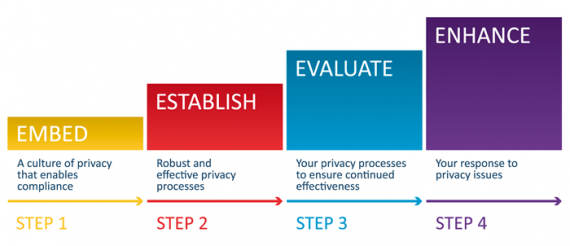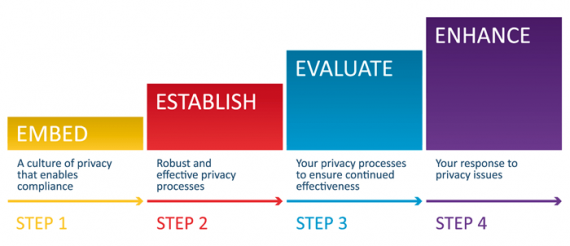KEEP IN TOUCH
Subscribe to our mailing list to get free tips on Data Protection and Cybersecurity updates weekly!







A privacy management plan is a document that identifies specific, measurable goals and targets that identify how you will implement the four steps outlined in the Framework. This template is designed to help you develop a privacy management plan for your entity. Which commitments you implement within each step, and who performs these, will depend upon your particular circumstances, including your entity’s size, resources and business model.
You may be able to adapt this template to include specific details around how you intend to implement each commitment. Alternatively, it could be appropriate to specify these details in a separate project plan, dependant on the size and scale of the relevant commitment.
Also read: PRIVACY MANAGEMENT PLAN

Creating a culture of privacy compliance within your organisation encourages team members to take responsibility for the businesses’ privacy obligations. This includes:
| Action | Person responsible | Due | Status |
|---|---|---|---|
| Adopt a ‘privacy by design’ approach | |||
| Assign key roles and responsibilities for privacy management | |||
| Assign staff responsibility for managing privacy | |||
| Create reporting mechanisms that ensure senior management are routinely informed about privacy issues | |||
| Ensure staff understand their privacy obligations and the roles |
Your business must implement procedures and practices for dealing with private information, including:
| Action | Person responsible | Due | Status |
|---|---|---|---|
| Keep information about your business’s personal information holdings (including the type of information you hold and where it is held) up to date | |||
| Develop and maintain processes around the handling of personal information prior to collection, while personal information is held and once it is no longer needed | |||
| Integrate privacy into staff training and induction processes | |||
| Develop and implement a clearly expressed and up to date privacy policy | |||
| Implement risk management processes to identify, assess and manage privacy risks across the business | |||
| Establish processes for receiving and responding to privacy inquiries and complaints | |||
| Establish processes that allow individuals to promptly and easily access and correct their personal information | |||
| Create a data breach response plan |
The plan should be subject to ongoing evaluation, involving:
| Action | Person responsible | Due | Status |
|---|---|---|---|
| Regularly monitor and review privacy processes, policies and notices | |||
| Document compliance with privacy obligations, including keeping records on privacy process reviews, breaches and complaints | |||
| Measure your performance against this privacy management plan | |||
| Create channels for staff and customers to provide feedback on privacy processes |
Also Read: What Is Governance Structure: Fundamentals for Gov’t Success
Your business should seek to amend and improve its processes to increase privacy and data security, by:
| Action | Person responsible | Due | Status |
|---|---|---|---|
| Use the results of evaluations to make changes to practices, procedures and systems to improve privacy processes | |||
| Have your privacy processes externally assessed/audited to identify areas for improvement | |||
| Keep up to date with issues and developments in privacy law and changing legal obligations | |||
| Monitor and address new security risks and threats | |||
| Examine and address the privacy implications, risks and benefits of new technologies. Consider implementing privacy enhancing technologies that allow you to minimise and better manage the personal information you handle | |||
| Introduce initiatives that promote good privacy standards in your business practices | |||
| Participate in Privacy Awareness Week and other privacy events |

Your plan should outline the measures that your business will put in place to comply. In other words, it should include your goals to avoid a data breach and build a culture of privacy compliance within your organisation.
Depending on the size and nature of your business, your plan may include:
Although your business is not legally required to have a plan, it is best practice to encourage customers’ and employees’ confidence in your processes. It published a template privacy management plan, which you can adapt to your business. This includes the four essential steps of a plan:
Also read: Privacy Management Plan